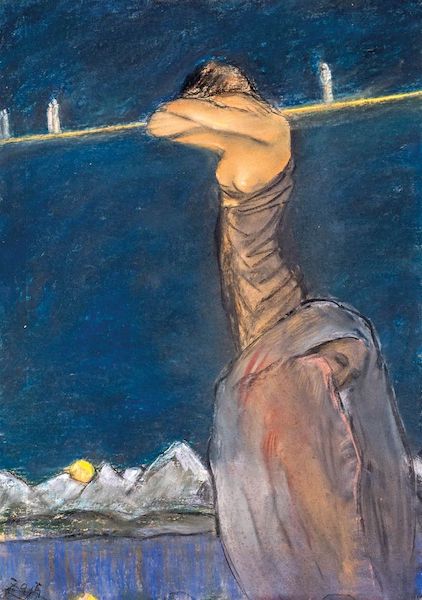Biography
His father, Pál Zajti, was the lord of the Szunyogh estate in Újfehértó, his mother, Terézia Szabó, both were Reformed. After graduating from the Reformed College in Debrecen, he studied in Budapest and then at Simon Hollósy's painting school in Munich. Later, returning to Hungary, he trained with Sándor Kubinyi and István Bosznay for six years.
In 1905, he began to deal with prehistory, the Scythian-Hungarian kinship. In 1907, he settled in Pestújhely and started working in the engineering department of Budapest Székesfőváros, organizing the combined material of the Pest and Buda plan archives. He presented himself as a painter in 1909. In the 1910s, he maintained a good relationship with Kosztka Tivadar Csontváry, who called him his spiritual successor and the continuation of his work. Later he had exhibitions in Hungary and Turkey.
During the First World War, he studied comparative religious history and oriental languages at the University of Debrecen Reformed Faculty of Religion. He performed here from 1917 and was appointed as a university professor from 1921. During the war, he established shelters in the capital, where he gave lectures mainly on religious and historical topics. He founded the series and newspaper "Popular Theological Course" for the wider dissemination of the lectures.
In 1918, his first work, "The Belief of the Old Magyars", was published. In 1919, he translated Zarathustra's Avesta from German, for which he created a series of 70 pictures. He published the work in his own edition. In 1922, he married Magdolna Rádi in Szigetvár, with whom he had several children. Together with Lord Rothermere, he participated in "Justice for Hungary", the action intended to revise the Trianon Peace Treaty. In 1921, he created a series of drawings with 40 pictures for his Jesus book ("The Childhood of Jesus"). In 1925, he invited Jivanji Jamshedji Modi, a professor specializing in Huns at the University of Bombay, to Hungary, who gave a lecture at the Hungarian Academy of Sciences in front of an audience of 1,600 people in the presence of Governor Miklós Horthy. Horthy later awarded the scientist with the Hungarian Cross of Merit. At the same time, Zajti launched the "Avezta Library" series, in which the studies of Aurél Stein, Ignác Goldziher, Géza Kuun and Jivanji Jamshedji Modi, among others, were published.
In 1928, he published the Hungarian Mythology of Arnold Ipolyi, born in 1854, which was the first attempt to reconstruct the original Hungarian religion. During the year, he invited the Indian poet Rabindranath Tagore and then traveled to India, where he sought out the "Gujjar Huns" of Scythian kinship. During the trip, he also visited Mahatma Gandhi's house. He returned home in March 1929 with a huge amount of ethnographic, industrial and fine arts materials, book rarities, and photo documentation, and became the vice-president of the Hungarian-Indian Society that was founded at that time. In the 1930s, with the patronage of Kemal Atatürk, he was elected a member of the 12-member committee of the Turkish Historical Society, and a Turkish-Hungarian encyclopedia was planned, of which six hundred pages were completed with Zajti's work. The work - with the death of Kemal Atatürk, the support ended - remained unfinished.
From 1933 until his retirement in 1946, he was the supervisor of the Eastern book collection of the Metropolitan Library. He dealt with the purchase of rare books and manuscripts, the discovery and republishing of documents, codices, and sources believed to be lost. As a summary of his research work, "Hungarian Millennials" was published in 1936. "Skytha-Hun-Hungarian racial identity", the second edition of which was published in 1943 and the facsimile edition in 1999. "Was Christ a Jew?" was published in 1936. His book "The Great Battle of Semitism and Scythism" stirred up a storm, in which he tried to prove that the disciples of Galilean origin and Jesus himself were natives of the former Scythian region.
He died in June 1961 in Budapest. His apartment was ransacked on the day of his death, his works, his library and almost all his valuables were lost. A fragment of his oeuvre is kept by the Hungarian National Gallery.


